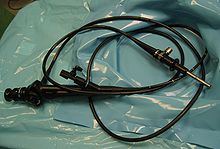Cystoscopy
The urethrocystoscopy (urethral and cystoscopy) is a urological examination of the urinary bladder , in which with a special endoscope , the cystoscope is examined (bubble levels), the urinary bladder. In men, the urethra is always examined.
history
The first device for examining the urinary bladder using a "light guide" was presented in 1807 by the doctor Philipp Bozzini . The first modern urethrocystoscope was presented to the public in Vienna on May 9, 1879 by the Dresden doctor Maximilian Nitze , who had developed an optical system with a light source inside the organ in 1877 . This day is considered to be the birth of modern urological endoscopy. On December 2, 1877, he received the imperial patent for his "kystoscope". Pioneers in the field of cystoscopy were then Friedrich Voelcker with Eugen Joseph in Heidelberg, Leopold Caspar (1859–1959) in Berlin, Joaquín Albarrán (Paris), Edwin-Hurry Fenwick (1856–1944) in London and Walter Stoeckel (Erlangen and Berlin ).
Indications
- if there is blood in the urine ( microhematuria or macrohematuria )
- if a bladder tumor is suspected
- in the context of tumor follow-up after bladder tumors
- if a foreign body is suspected in the bladder or urethra
- as part of the investigation with frequent bladder infections
- for urination disorders if there is a suspicion of an obstruction to drainage
- for urinary incontinence to assess the sphincter
- if a fistula formation between the bladder and the intestine or vagina is suspected
- if a urethral narrowing is suspected
Contraindications
Urethrocystoscopy should not be performed if the urethra, urinary bladder, prostate, and epididymis are infected . There is a risk of the spread of germs and thus acute exacerbation or spread of the infection. If, however, a mirror is required for diagnosis, sufficient antibiotics must be given beforehand.
Investigation technique
Flexible or rigid cystoscopes are available for cystoscopy. The examination takes place lying down. A general anesthetic is not in adults usually necessary. In children, cystoscopy is performed under anesthesia. The examination is carried out in compliance with sterility . The examination is usually carried out as a so-called video urethrocystoscopy. Here, the image is transmitted to a screen via a camera attached to the optics . Patients can follow the examination on a second screen. The examination can be recorded using a video recorder . With both methods, the bladder is filled with sterile fluid using the instrument and then rinsed.
Rigid urethrocystoscopy
Rigid urethrocystoscopy is performed in the so-called lithotomy position . The patient lies on their back and their legs are bent and spread outwards. In men, the device is pushed forward through the urethra and into the bladder. Up to the urinary bladder, an optic is used that looks strictly straight ahead (0 ° or 5 ° angle). An optic with an angle of 30 °, 70 ° or 120 ° is then used in the bladder. During the examination, the urethra up to the external sphincter is assessed first. The prostatic urethra is then assessed . After changing the optics, the entire urinary bladder is systematically examined. In women, the device is usually inserted blindly, i. H. the optics are only used after reaching the urinary bladder.
Flexible urethrocystoscopy
In contrast to rigid urethrocystoscopy, the patient can also lie flat on their back with flexible urethrocystoscopy. The assessment is carried out in the same way as the rigid procedure.
Advantages and disadvantages of both examination techniques
The rigid technology offers better flushing and manipulation options due to larger working channels. The performance of the optics used and the light output are better. Compared to the flexible technique, however, it is more often perceived as uncomfortable to painful. The flexible procedure has the advantage that it can also be used when lithotomy storage is not possible. The flexible tip means that there is no need to change the optics.
Complications
Possible complications of a urethrocystoscopy are, in addition to the spread of germs, above all direct injuries to the urethra and bladder caused by the instrument , which can also temporarily lead to the appearance of blood in the urine. The temporary occurrence of urinary incontinence is also described. In addition to the hole ( perforation ), small injuries to the mucous membrane can occur, which can lead to urethral constrictions in the urethra. Not infrequently, a cystoscopy in men leads to chronic non-bacterial prostatitis .
literature
- Horst Kremling : The cystoscopy - historical considerations. In: Würzburger medical history reports 11, 1993, pp. 5-8.
See also
- Transurethral resection
- Ureteroscopy (ureteroscopy)
- Ureterorenoscopy (ureter and kidney mirroring)
Web links
- urologielehrbuch.de - numerous picture examples (normal and pathological findings)
Individual evidence
- ↑ Horst Kremling: On the development of endovesical color photography. In: Würzburger medical historical reports 2, 1984, pp. 5-7; here: p. 5.
- ↑ Horst Kremling: On the development of clinical diagnostics. In: Würzburger medical history reports 23, 2004, pp. 233–261; here: p. 239.
- ↑ Horst Kremling (1993), p. 6.
